The gravel crunched beneath my boots as I walked the lonely road down the hill toward the Snake River, my shotgun cradled across my left arm, and my tired old mutt wandering slowly by my side.
My feet were killing me. I had the makings of a couple of new blisters, and I'd managed to turn my ankle pretty good earlier that morning as we trudged across the steppe looking for huns. Then, as we walked an edge in search of the pheasants that taunted us by leaving behind very clear fork-shaped prints in the remnants of last week's snow, I tweaked it again. I was exhausted — months spent largely sitting behind a desk had trickled the last of whatever was left of my stamina out of my bones. But I wasn't about to admit it. I masked the limp as best I could and powered through the pain in my toes (I learned later that I ripped one of my toenails completely off my toe).
"There are three things you need if you're serious about bird hunting," my good friend and an excellent wingshooter, Greg McReynolds, said to me as we walked slowly through the brush, half-heartedly hoping to move a flock of huns, and half expecting more of what we'd experienced most of the day, which wasn't much.
"You need a dog, good shotgun shells and a good pair of boots. And I'm serious about the boots."
I looked down at my perfectly serviceable hiking boots that had taken me happily along trails all over the West. Then I realized my folly. Trails. Busting through brush and walking ditch rows behind eager dogs doesn't give the upland bird hunter the luxury of trails. Disturbed earth, rocks hidden under matted cheatgrass ... gopher holes that twist ankles ... they conspire against the tender-footed.
Boots. I now own good ones.
My dog at the time, Hannah, had her heart in the right place. She was an instinctive bird dog, but not a trained shotgun dog. And she hunted about as much as I did, which meant by the end of the day, she was as tired as I was. And as we walked slowly along the gravel road, relieved to be on level ground, she reluctantly marched by my side. Hours earlier, she happily pushed through cattails and ranged through sage searching for pheasants. Now, she walked on tender pads, tail a little droopy, but ears ever alert. Even this spent, she was attentive.
In the distance, in the shade of the draw below us, we saw some birds moving.
"Collared doves," Greg said, almost dismissively. "We can shoot them. There's no limit."
Indeed, Eurasian collared doves, at least in Idaho, are now officially a scourge, likely competing with native mourning doves for habitat, and perhaps even stressing more sensitive native game birds, like mountain quail and California quail and sage grouse. These days, they’re as likely to be seen on power lines, flying through neighborhoods and roosting under freeway overpasses as the equally non-native pigeon.
These beautiful birds first arrived on Western shores when they were imported as domestic pets in the Caribbean in the 1970s. By the early 80s, they were nesting in south Florida. A decade later, they were common all over the Southeast. A decade after that, they'd arrived in Idaho following a northwest expansion pattern that has seen them turn up as far north as Alaska.
Hearty birds that don't truly migrate — they simply expand their range, as they've done all across North America in a little over 30 years — Eurasian collared doves resemble mourning doves, but they're a quite a bit larger, and have a black "collar" on the backs of their necks. They might not be quite as big as a common banded pigeon, but they're not far off. Over the years, as I've come to see more and more of them all across Idaho, and at all times of the year, I've wondered about their habits, their habitat ... and their table fare.
As we got a bit closer, it became obvious that we'd stumbled upon this flock's roost, a stand of junipers lining a deep wash that tumbled down from the rim of the Snake River Plain to the water's edge. Dozens — maybe hundreds — of these big doves glided in and out of the junipers. Still well out of range, the itch to simply put a bird in my sights and pull the trigger on my father's old Remington 12-banger was almost more than I could stand. As we slowly marched a little closer, the birds got restless, but they didn't disperse. They were home for the night, and they weren't going to leave unless the approaching visitors turned out to be hostile.
And hostile we were.
I got close enough to where I felt comfortable taking a shot, and as soon as one of the doves left the roost and took flight, I raised my gun and fired. Feathers flew, and I was certain I had a bird down, so I moved to the next target, pumped the spent shell from the chamber and fired again. A clear miss, just a hair behind the target. A third shot was apparently errant, as well.
As I noted, I'm not a seasoned bird hunter, so a 33-percent success rate seemed pretty good to me. Hannah and I walked up on the juniper grove and we both combed the ground looking for my first collared dove. And we looked. And looked some more.
Greg brought his dog, Roxy, a seasoned bird dog, over to help us, but no luck. My suspicion is that I simply tagged the bird with just a taste of shot, and it sped off into the desert where, I'm guessing, it eventually became a nice meal for a fox or a coyote. It sure didn't end up in my freezer. A pang of guilt washed over me, but Greg wouldn't have it.
"Don't sweat it," he said. Then, in my language, he said: "It's like throwing a brookie on the bank when you're fishing a cutthroat stream."
The birds had moved over a ridge, but their odd flight pattern and the occasional appearance of a single or a double indicated that they really wanted to come back and roost in this thick copse of trees. Greg, taking pity on my sore feet, volunteered to wander around the next bluff and try to push the flock to me, where Hannah and I would wait. He and Roxy disappeared a few hundred yards away, and a few minutes later, I heard a single shot. Not long after that, a pair of collared doves appeared over the rimrock and made for the trees where Hannah and I sat in ambush. They flew into range, and I fired.
The trailing dove went down in a blast of feathers. Success.
Greg returned a few minutes later. Minutes after that, Roxy found my dove, dead in some thick brush.
We likely could have holed up in the trees and waited — I think the flock would have returned in time. But, with a day slowly slipping away, and the chance at a pheasant or two still in the cards, we humped it back to the car and fruitlessly pursued more prestigious prey until shooting hours expired.
The dove was our only take of the day, prompting me to calculate the investment I made into the hunting endeavor. I figured, between a tank of gas and the Arby's drive-thru I hit on the way home, I likely put $50 bucks into the two little breast medallions I gleaned from the gorgeous little immigrant.
So I figure the Eurasian collared dove population owed me one. And, in the years since, I’ve done my best to collect.





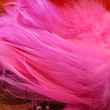















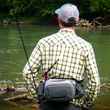
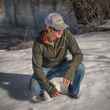



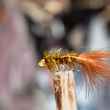
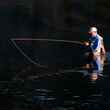


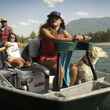

Comments
FliesWithAMission replied on Permalink
Sounds like we need to come up with 20 or 30 really good fly patterns that use Eurasian collared dove feathers and promote the heck out of 'em.
Pages